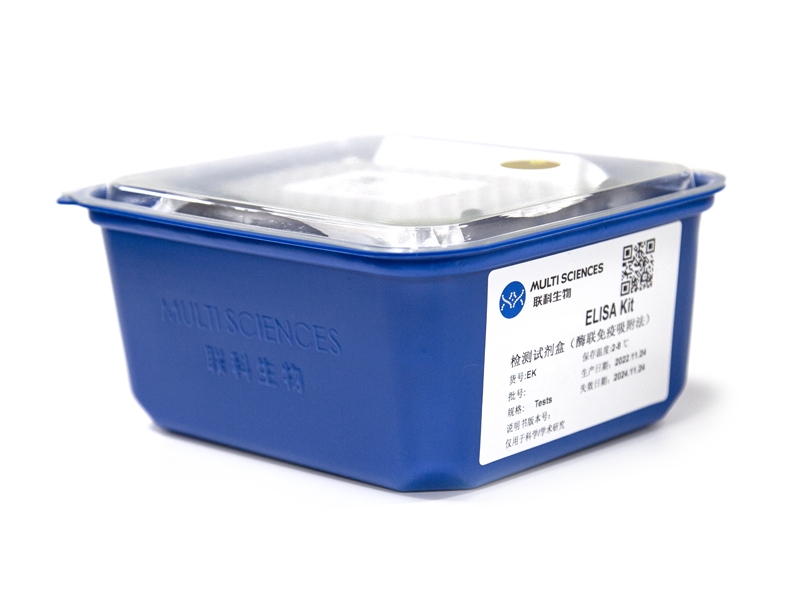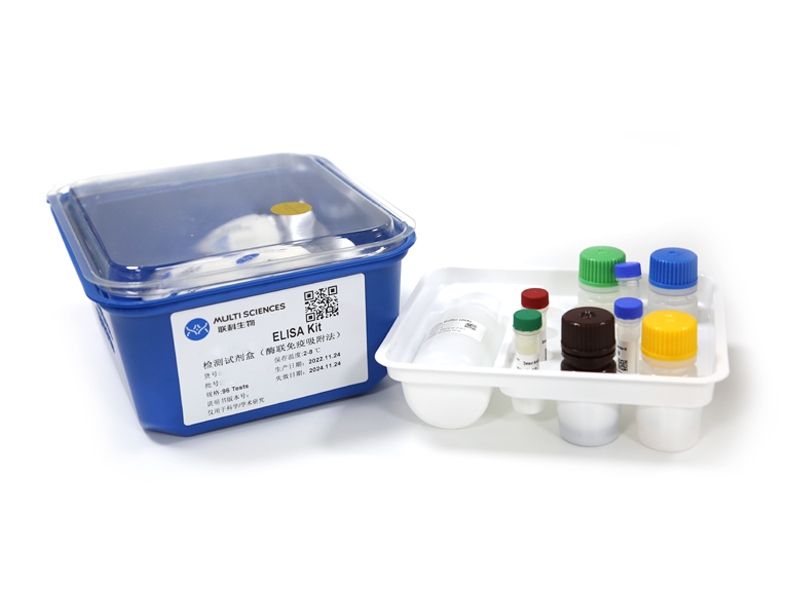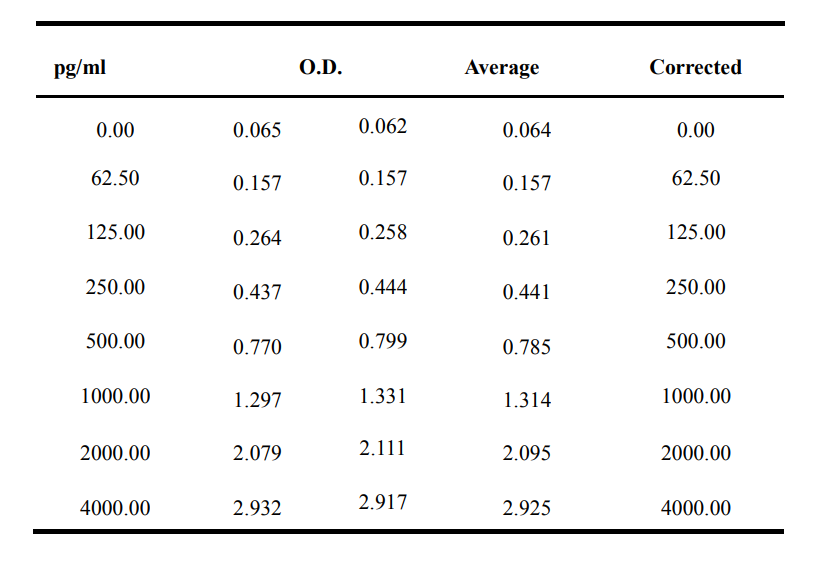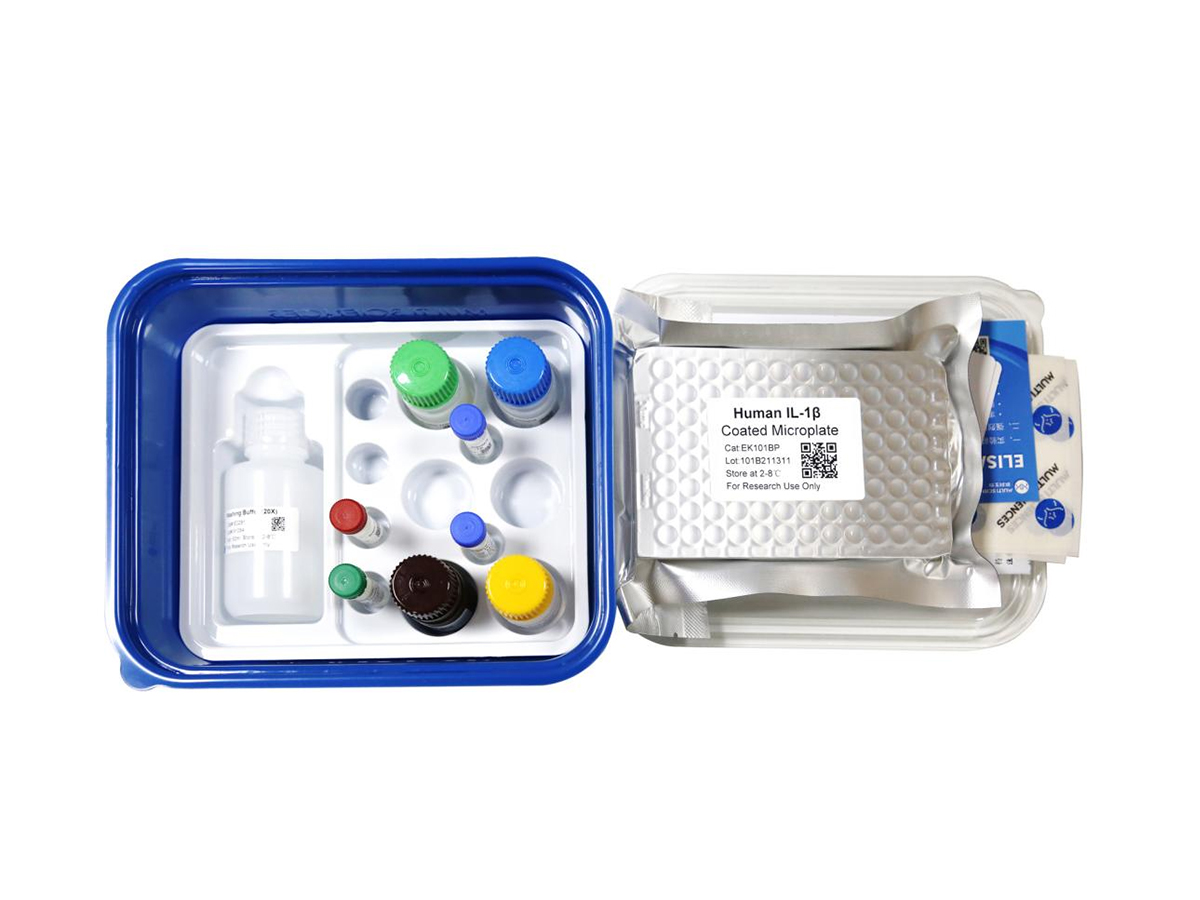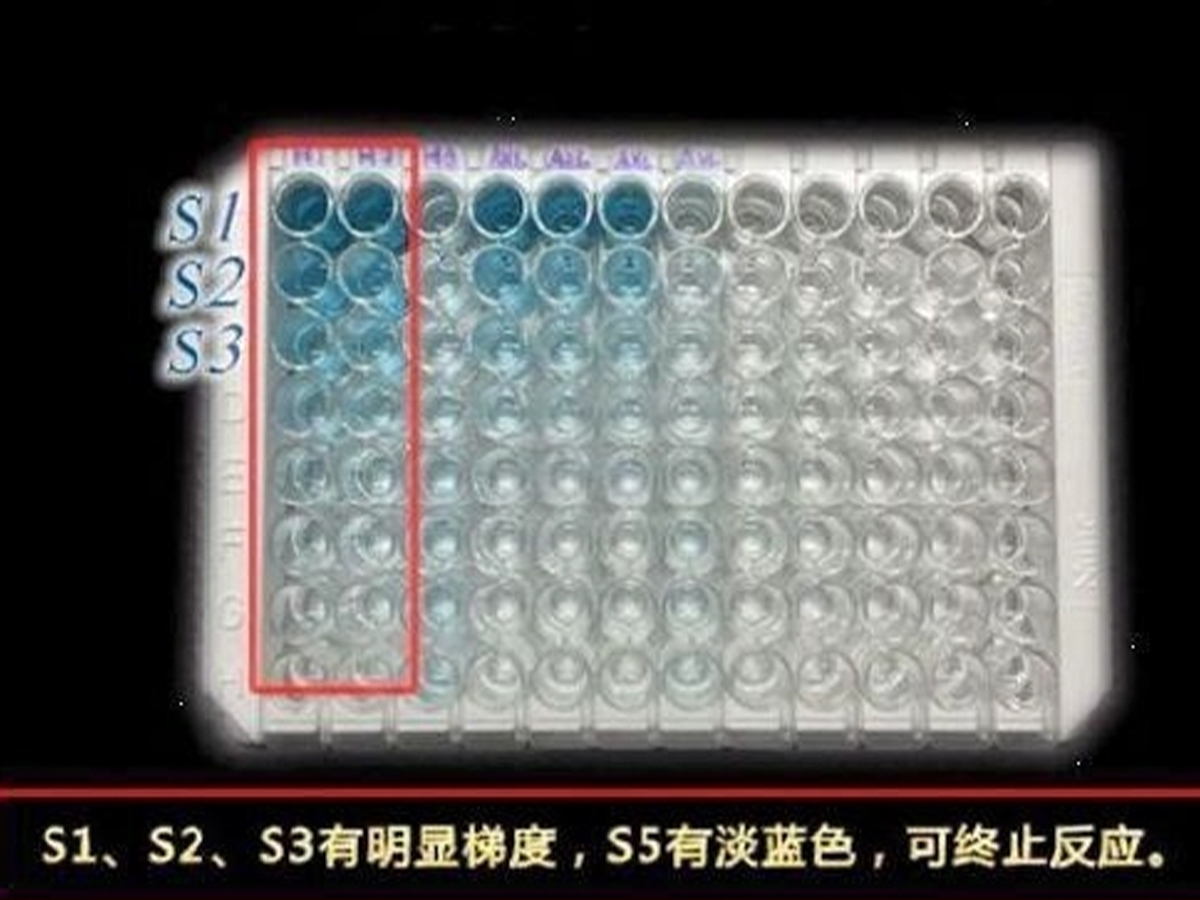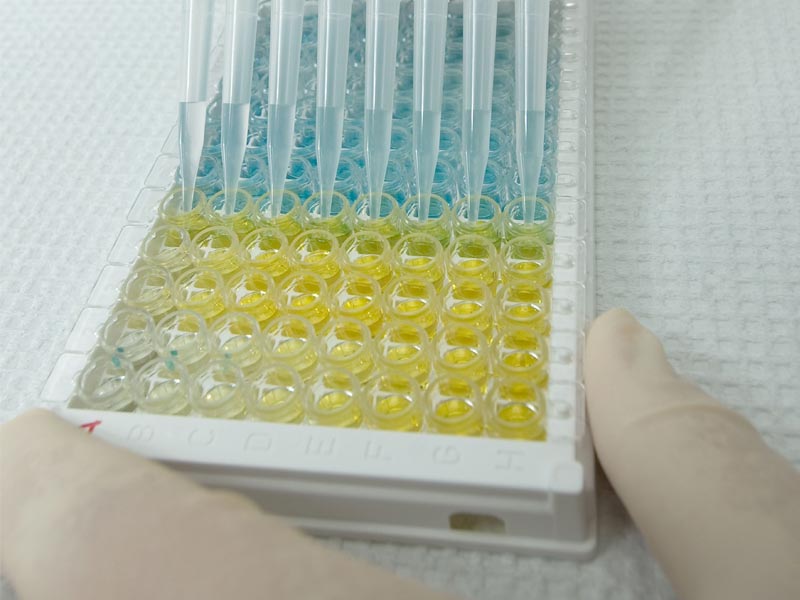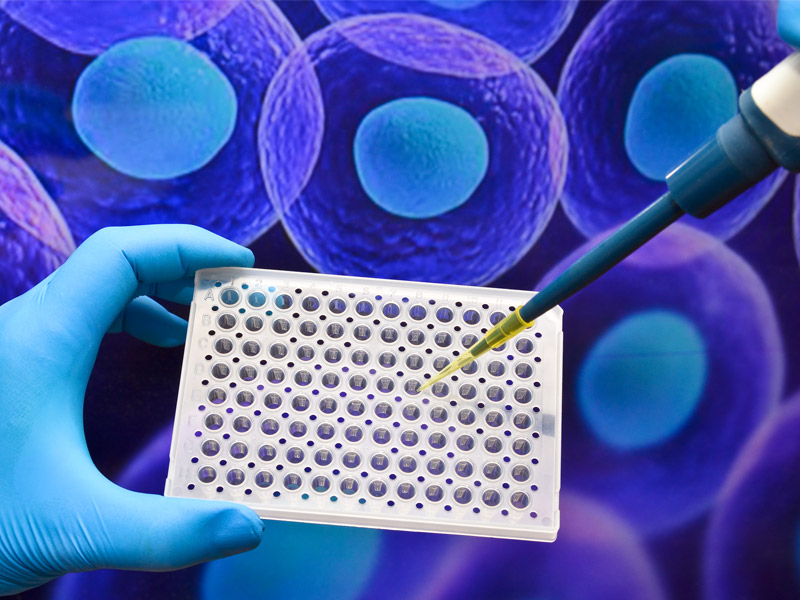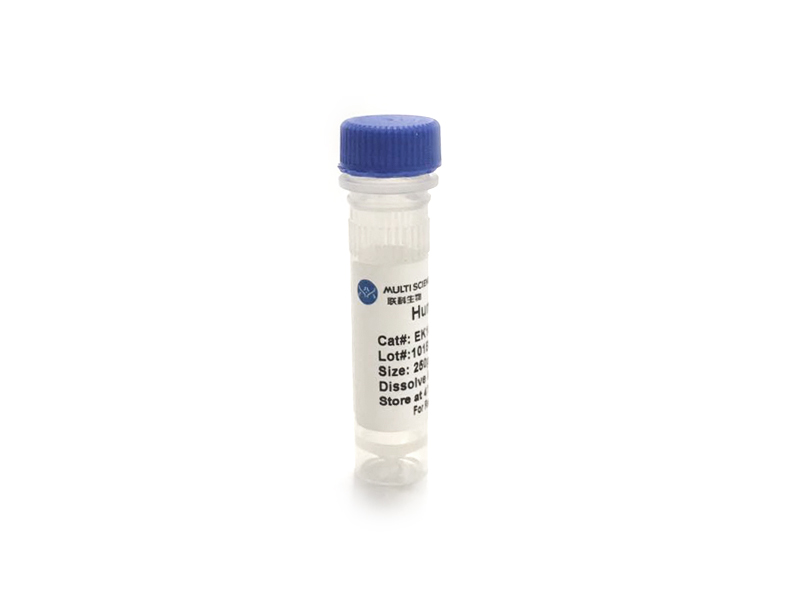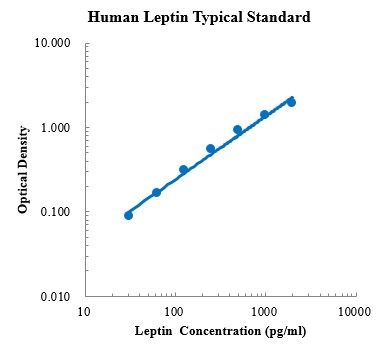Mouse Leptin ELISA Kit检测试剂盒(酶联免疫吸附法)
¥1,600.00 – ¥2,650.00
因产品会迭代升级,具体实验步骤请按纸质版说明书操作
- 分子靶点:LEP, OBS, OB
- 种属:小鼠 (Mouse)
- 样本类型:血清,血浆,细胞培养上清及其他生物学样本
- 检测样本体积:10 μL
- 灵敏度:2.48 pg/mL
- 检测范围:62.5 pg/mL - 4000 pg/mL
- 回收率:73% - 120%
在售SKU:70-EK297-48, 70-EK297-96 小鼠瘦素 小鼠 瘦素
描述
| 商品名 |
Mouse Leptin ELISA Kit (小鼠瘦素 ELISA试剂盒) |
|---|---|
| 检测方法 |
双抗夹心法 |
| 精密度 |
板内变异系数:3.9%-5.9%;板间变异系数:2.0% - 2.1% |
| 样本类型 |
血清,血浆,细胞培养上清及其他生物学样本 |
| 检测样本体积 |
10 μL |
| 灵敏度 |
2.48 pg/mL |
| 检测范围 |
62.5 pg/mL - 4000 pg/mL |
| 回收率 |
73% - 120% |
| 平均回收率 |
1.02 |
| 板式 |
96孔板,可拆 |
| 保存 |
试剂盒未拆开,4℃保存。已拆开,标准品-20℃保存,其它4℃保存。 |
| 运输条件 |
4℃蓝冰运输 |
| 组分 |
|
检测原理:本试剂盒采用双抗体夹心酶联免疫吸附检测技术。特异性抗小鼠Leptin抗体预包被在高亲和力的酶标板上。酶标板孔中加入标准品、待测样本和生物素化的检测抗体,经过孵育,样本中存在的Leptin与固相抗体和检测抗体结合。洗涤去除未结合的物质后,加入辣根过氧化物酶标记的链霉亲和素(Streptavidin-HRP)。洗涤后,加入显色底物TMB,避光显色。颜色反应的深浅与样本中Leptin的浓度成正比
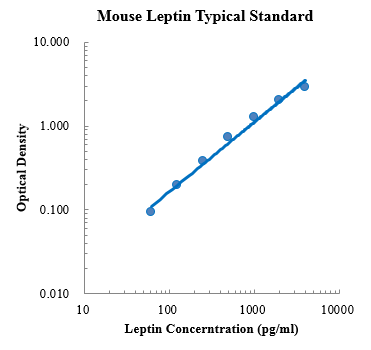
分子信息
LEP 分子靶点信息概述
- 分子名:LEP, leptin
- 基因家族:Neuropeptides
- 曾用名:OBS; OB
- 全称:leptin (murine obesity homolog); leptin (obesity homolog, mouse)
LEP 分子靶点综述
瘦素是由脂肪细胞分泌的蛋白质类激素,可通过抑制饥饿来调控能量平衡。除了白色脂肪组织可以分泌瘦素外,褐色脂肪、胎盘、卵巢、骨骼肌、胃、乳腺上皮细胞、骨髓和P/D1细胞也能产生瘦素。瘦素和饥饿激素都作用于下丘脑弓状核的受体,以此来调节食欲,获得能量平衡。瘦素的基本功能是调节脂肪储存,但它在其它生理代谢过程中同样发挥作用,然而许多其它功能还未明确。研究表明瘦素与肥胖和减肥有关联。
小鼠 Mouse Lep 分子靶点信息
- 分子名:Lep, leptin
- 别称:
- ob
- obese
- 基因序列:NCBI_Gene: 16846
- 蛋白序列:
小鼠 Mouse Lep 靶点分子功能(预测)
Enables DNA binding activity and growth factor activity. Involved in several processes, including cell surface receptor signaling pathway; positive regulation of cytokine production; and positive regulation of signal transduction. Acts upstream of or within several processes, including insulin secretion; monocarboxylic acid metabolic process; and regulation of insulin secretion. Located in cytoplasm and extracellular space. Is expressed in several structures, including adipose tissue; alimentary system; central nervous system; early conceptus; and genitourinary system. Used to study abdominal obesity-metabolic syndrome (multiple); fatty liver disease (multiple); obesity; and type 2 diabetes mellitus. Human ortholog(s) of this gene implicated in several diseases, including alcohol dependence; congenital leptin deficiency; liver disease (multiple); lung disease (multiple); and type 2 diabetes mellitus. Orthologous to human LEP (leptin).
引用文献统计
该产品被引用的文献总数为:19
- Limits to sustained energy intake. XXX. Constraint or restraint? Manipulations of food supply show peak food intake in lactation is constrained
影响因子:3.014刊物:JOURNAL OF EXPERIMENTAL BIOLOGY发表日期:2020/4/15 - In vivo self-assembled small RNAs as a new generation of RNAi therapeutics
影响因子:25.617刊物:CELL RESEARCH发表日期:2021/3/29 - Actin related protein 2/3 complex subunit 1 up-regulation in the hypothalamus prevents high-fat diet induced obesity
影响因子:3.698刊物:EUROPEAN JOURNAL OF NEUROSCIENCE发表日期:2022/11/16 - Rutin and Its Combination With Inulin Attenuate Gut Dysbiosis, the Inflammatory Status and Endoplasmic Reticulum Stress in Paneth Cells of Obese Mice Induced by High-Fat Diet
影响因子:4.019刊物:Frontiers in Microbiology发表日期:2018/11/5 - Gut microbiota mediates the anti-obesity effect of calorie restriction in mice
影响因子:4.122刊物:Scientific Reports发表日期:2018/8/29 - GPAT3 deficiency alleviates insulin resistance and hepatic steatosis in a mouse model of severe congenital generalized lipodystrophy
影响因子:4.544刊物:HUMAN MOLECULAR GENETICS发表日期:2019/12/24 - Glucocorticoid exposure affects female fertility by exerting its effect on the uterus but not on the oocyte: lessons from a hypercortisolism mouse model
影响因子:4.99刊物:HUMAN REPRODUCTION发表日期:2018/11/2 - Effects of ambient temperatures between 5 and 35 °C on energy balance, body mass and body composition in mice
影响因子:8.568刊物:Molecular Metabolism发表日期:2022/7/20 - Weight-Reducing Effect of Lactobacillus Plantarum ZJUFT17 Isolated from Sourdough Ecosystem
影响因子:4.546刊物:Nutrients发表日期:2020/4/1 - Fibroblast transdifferentiation promotes conversion of M1 macrophages and replenishment of cardiac resident macrophages following cardiac injury in mice
影响因子:4.404刊物:EUROPEAN JOURNAL OF IMMUNOLOGY发表日期:2020/2/18 - Remodeling on adipocytic physiology of organophosphorus esters in mature adipocytes
影响因子:9.988刊物:ENVIRONMENTAL POLLUTION发表日期:2022/4/11 - Legumain-deficient macrophages regulate inflammation and lipid metabolism in adipose tissues to protect against diet-induced obesity
影响因子:3.8刊物:MOLECULAR AND CELLULAR ENDOCRINOLOGY发表日期:2024-05-28 - Epigallocatechin gallate suppresses mitotic clonal expansion and adipogenic differentiation of preadipocytes through impeding JAK2/STAT3-mediated transcriptional cascades
影响因子:6.7刊物:PHYTOMEDICINE发表日期:2024-03-22 - SIRT1 inhibitors within Qing-Luo-Yin alleviated white adipose tissues-mediated inflammation in antigen-induced arthritis mice
影响因子:7.9刊物:PHYTOMEDICINE发表日期:2023-10-04 - Chinese chestnut shell polyphenol extract regulates the JAK2/STAT3 pathway to alleviate high-fat diet-induced, leptin-resistant obesity in mice
影响因子:6.1刊物:Food & Function发表日期:2023-04-26 - CircHOMER1 inhibits porcine adipogenesis via the miR-23b/SIRT1 axis
影响因子:4.8刊物:FASEB JOURNAL发表日期:2023-02-21 - Rutin and Its Combination with Inulin Attenuate Gut Dysbiosis, the Inflammatory Status and Endoplasmic Reticulum Stress in Paneth Cells of Obese Mice Induced by High-Fat Diet
刊物:Frontiers in microbiology 9, 2651 (2018) - Glucocorticoid Exposure Affects Female Fertility by Exerting Its Effect on the Uterus but Not on the Oocyte: Lessons from a Hypercortisolism Mouse Model
刊物:Human reproduction (Oxford, England) 33, 2285-2294 (2018) - Human Epidermal Growth Factor Receptor-2 Antibodies Enhance the Specificity and Anticancer Activity of Light-Sensitive Doxorubicin-Labeled Liposomes
刊物:Biomaterials 57, 1-11 (2015)
ELISA试剂盒操作常见问题查看更多ELISA试剂盒操作步骤技术文章
查看更多ELISA试剂盒操作步骤技术文章
操作步骤
文章目录[隐藏]
- ELISA操作常见问题
- 小心!你的 ELISA 试剂盒可能是假的
- 开学学习计划,如何收集ELISA检测样本——细胞
- 开学学习计划,如何选择ELISA试剂盒
- 开学学习计划,ELISA从新手到入门!
- 一文掌握ELISA实验显色判断、数据分析及标曲拟合
- 血清OR血浆,哪个是ELISA的菜
- ELISA通关必备丨数据篇丨标准曲线不佳
- ELISA通关必备丨操作篇丨常见问题及解决方案
- ELISA通关必备丨操作篇丨溶解与稀释标准品
- ELISA通关必备丨样本篇丨不常见样本
- ELISA通关必备丨样本篇丨常见样本丨细胞
- ELISA通关必备丨如何选择试剂盒
- ELISA通关必备丨基础知识
- 真?假?ELISA试剂盒选择要小心
- ELISA常见类型一 | 双抗夹心法,你要的都在这里!
- ELISA常见类型二 | 竞争法,五分钟搞定!
- 叮!联科向您投递了个ELISA实验操作干货包,请查收~
- 【视频】ELISA实验操作步骤演示视频教程
- ELISA 组织样本的处理—大鼠组织
- 【视频】ELISA实验原理与常见问题分析
- 查看更多ELISA操作相关问题
ELISA操作常见问题
查看更多ELISA操作相关问题
引用文献
文章目录[隐藏]
- Limits to sustained energy intake. XXX. Constraint or restraint? Manipulations of food supply show peak food intake in lactation is constrained
- In vivo self-assembled small RNAs as a new generation of RNAi therapeutics
- Actin related protein 2/3 complex subunit 1 up-regulation in the hypothalamus prevents high-fat diet induced obesity
- Rutin and Its Combination With Inulin Attenuate Gut Dysbiosis, the Inflammatory Status and Endoplasmic Reticulum Stress in Paneth Cells of Obese Mice Induced by High-Fat Diet
- Gut microbiota mediates the anti-obesity effect of calorie restriction in mice
- GPAT3 deficiency alleviates insulin resistance and hepatic steatosis in a mouse model of severe congenital generalized lipodystrophy
- Glucocorticoid exposure affects female fertility by exerting its effect on the uterus but not on the oocyte: lessons from a hypercortisolism mouse model
- Effects of ambient temperatures between 5 and 35 °C on energy balance, body mass and body composition in mice
- Weight-Reducing Effect of Lactobacillus Plantarum ZJUFT17 Isolated from Sourdough Ecosystem
- Fibroblast transdifferentiation promotes conversion of M1 macrophages and replenishment of cardiac resident macrophages following cardiac injury in mice
- Remodeling on adipocytic physiology of organophosphorus esters in mature adipocytes
- Legumain-deficient macrophages regulate inflammation and lipid metabolism in adipose tissues to protect against diet-induced obesity
- Epigallocatechin gallate suppresses mitotic clonal expansion and adipogenic differentiation of preadipocytes through impeding JAK2/STAT3-mediated transcriptional cascades
- SIRT1 inhibitors within Qing-Luo-Yin alleviated white adipose tissues-mediated inflammation in antigen-induced arthritis mice
- Chinese chestnut shell polyphenol extract regulates the JAK2/STAT3 pathway to alleviate high-fat diet-induced, leptin-resistant obesity in mice
- CircHOMER1 inhibits porcine adipogenesis via the miR-23b/SIRT1 axis
- Rutin and Its Combination with Inulin Attenuate Gut Dysbiosis, the Inflammatory Status and Endoplasmic Reticulum Stress in Paneth Cells of Obese Mice Induced by High-Fat Diet
- Glucocorticoid Exposure Affects Female Fertility by Exerting Its Effect on the Uterus but Not on the Oocyte: Lessons from a Hypercortisolism Mouse Model
- Human Epidermal Growth Factor Receptor-2 Antibodies Enhance the Specificity and Anticancer Activity of Light-Sensitive Doxorubicin-Labeled Liposomes
Limits to sustained energy intake. XXX. Constraint or restraint? Manipulations of food supply show peak food intake in lactation is constrained
In vivo self-assembled small RNAs as a new generation of RNAi therapeutics
Actin related protein 2/3 complex subunit 1 up-regulation in the hypothalamus prevents high-fat diet induced obesity
Rutin and Its Combination With Inulin Attenuate Gut Dysbiosis, the Inflammatory Status and Endoplasmic Reticulum Stress in Paneth Cells of Obese Mice Induced by High-Fat Diet
Gut microbiota mediates the anti-obesity effect of calorie restriction in mice
GPAT3 deficiency alleviates insulin resistance and hepatic steatosis in a mouse model of severe congenital generalized lipodystrophy
Glucocorticoid exposure affects female fertility by exerting its effect on the uterus but not on the oocyte: lessons from a hypercortisolism mouse model
Effects of ambient temperatures between 5 and 35 °C on energy balance, body mass and body composition in mice
Weight-Reducing Effect of Lactobacillus Plantarum ZJUFT17 Isolated from Sourdough Ecosystem
Fibroblast transdifferentiation promotes conversion of M1 macrophages and replenishment of cardiac resident macrophages following cardiac injury in mice
Remodeling on adipocytic physiology of organophosphorus esters in mature adipocytes
Legumain-deficient macrophages regulate inflammation and lipid metabolism in adipose tissues to protect against diet-induced obesity
Epigallocatechin gallate suppresses mitotic clonal expansion and adipogenic differentiation of preadipocytes through impeding JAK2/STAT3-mediated transcriptional cascades
SIRT1 inhibitors within Qing-Luo-Yin alleviated white adipose tissues-mediated inflammation in antigen-induced arthritis mice
Chinese chestnut shell polyphenol extract regulates the JAK2/STAT3 pathway to alleviate high-fat diet-induced, leptin-resistant obesity in mice
CircHOMER1 inhibits porcine adipogenesis via the miR-23b/SIRT1 axis
Rutin and Its Combination with Inulin Attenuate Gut Dysbiosis, the Inflammatory Status and Endoplasmic Reticulum Stress in Paneth Cells of Obese Mice Induced by High-Fat Diet
Glucocorticoid Exposure Affects Female Fertility by Exerting Its Effect on the Uterus but Not on the Oocyte: Lessons from a Hypercortisolism Mouse Model
Human Epidermal Growth Factor Receptor-2 Antibodies Enhance the Specificity and Anticancer Activity of Light-Sensitive Doxorubicin-Labeled Liposomes

